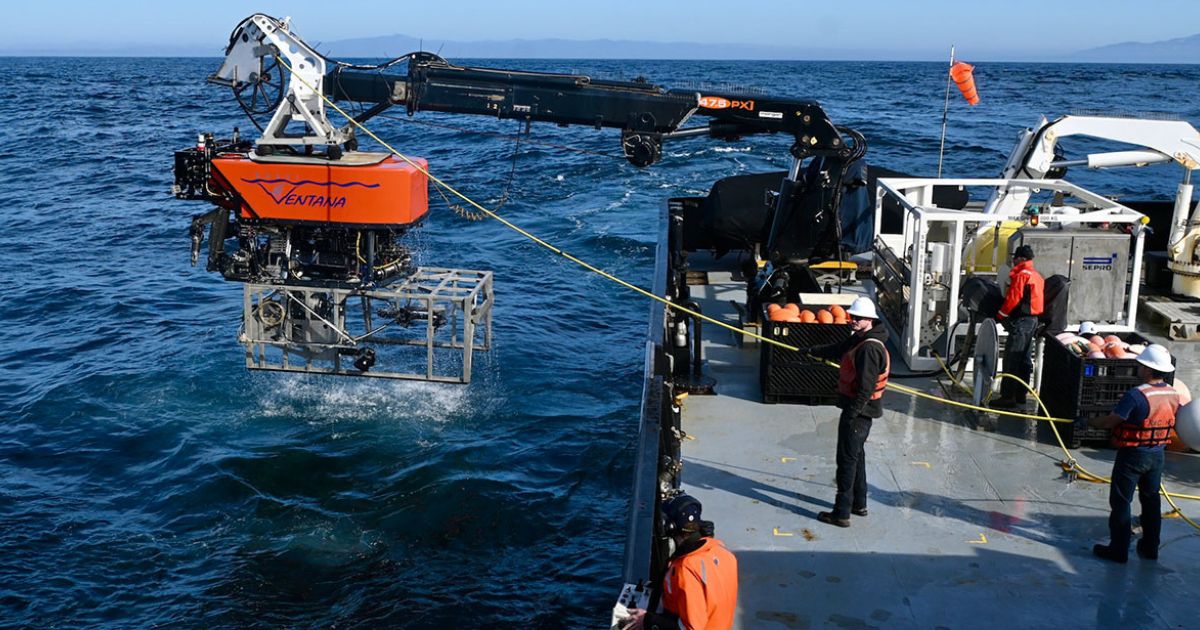Earlier in October 2023, MBARI’s (Monterey Bay Aquarium Research Institute) remotely operated vehicle (ROV) Ventana marked a major milestone in ocean exploration, completing its 4,500th dive for deep-sea science.
In operation since 1988, this robotic submersible has logged the most science dives of any remotely operated vehicle in the world.
“The pilots and crew that work with Ventana pride ourselves on taking the seemingly impossible dreams of our scientists and engineers and making them a reality. We keep pushing the envelope with Ventana,” said ROV Pilot/Technician DJ Osborne, who has been a pilot with Ventana for 22 years.
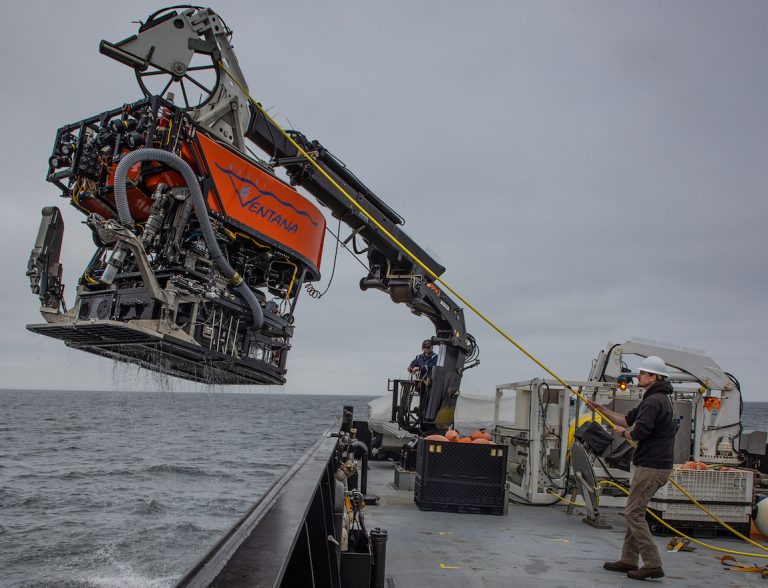 MBARI’s submersible pilots and marine operations crew have been integral to the success of the ROV Ventana. From launch to recovery, this team meticulously tends to the vehicle to ensure smooth science and engineering operations. (Image credit: Lori Eanes, Monterey Bay Aquarium)
MBARI’s submersible pilots and marine operations crew have been integral to the success of the ROV Ventana. From launch to recovery, this team meticulously tends to the vehicle to ensure smooth science and engineering operations. (Image credit: Lori Eanes, Monterey Bay Aquarium)
Ventana is a remotely operated vehicle launched from MBARI’s research vessel Rachel Carson. From a control room in the heart of the ship, a team of pilots and scientists steer the submersible as it explores the waters 1,800 meters (a little more than one mile) below. Ventana has been critical to MBARI’s mission to advance marine science and engineering to understand our changing ocean.
Ventana completed this milestone dive on October 10, during a three-day expedition to Sponge Ridge, a rocky crest in Monterey Canyon. Researchers deployed the ROV Ventana for a series of mapping surveys with MBARI’s Low-Altitude Survey System (LASS). Engineers from the Seafloor Mapping Lab and the Control, Modeling, and Perception of Autonomous Systems (CoMPAS) Laboratory were at sea to test new software for the LASS.
“My first dive with Ventana was 24 years ago, in 1999, and all the development projects I’ve participated in since have involved Ventana at some stage, even if the ultimate result yielded equipment somewhere far away on a different ROV or an autonomous vehicle,” recalled Principal Engineer Dave Caress, who leads MBARI’s Seafloor Mapping Lab and was the chief scientist for ROV Ventana’s record-setting dive. “It was only when I sat down in the control room and started to take notes that I realized our first dive would have the nice round number of 4,500. So, it was a normal day at sea, and yet very special, and a privilege at the same time.”
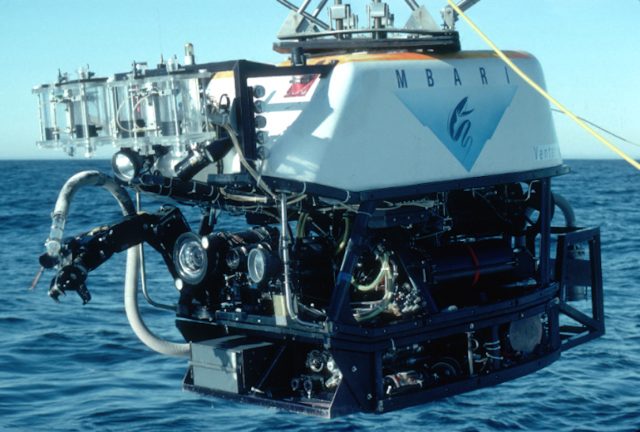 Ventana’s original configuration included a white foam pack for buoyancy. Over the vehicle’s 35-year history, MBARI engineers and marine operations team have made significant upgrades to the vehicle. (Image credit: Steve Etchemendy, MBARI)
Ventana’s original configuration included a white foam pack for buoyancy. Over the vehicle’s 35-year history, MBARI engineers and marine operations team have made significant upgrades to the vehicle. (Image credit: Steve Etchemendy, MBARI)
ROV Ventana was constructed for MBARI in 1987 by International Submarine Engineering Ltd. (ISE) in Canada. At the time, most remotely operated vehicles were used by the oil industry. After three months of construction and a month of sea trials, the core vehicle and tool-sled frame were shipped to Monterey, then the MBARI team got to work customizing Ventana for science operations. The vehicle began its first test dives in September 1988, and was fully operational by the end of the year.
Ventana has coevolved with the ever-expanding research needs of MBARI researchers. The robot is a versatile platform for deep-sea science and engineering. A dexterous manipulator arm allows researchers to deploy a variety of underwater technologies, and when needed, marine operations crew can mount a second manipulator arm on the vehicle for more complex experiments. A suite of advanced instruments can be installed on the vehicle to support the diverse needs of MBARI researchers, from collecting samples of deep-sea sediments to visualizing the structure of delicate drifters.
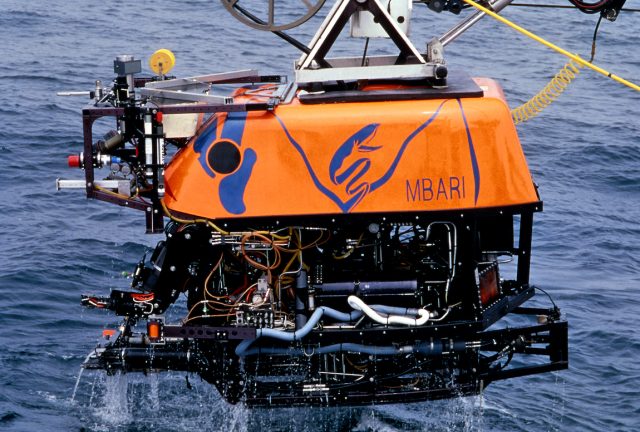 In 1995, Ventana underwent a significant overhaul with a new larger frame and foam pack. The foam pack was painted orange and blue, similar to the bluebanded goby (Lythrypnus dalli), a fish found in rocky reefs off the California coast. (Image credit: Karen Salamy, MBARI)
In 1995, Ventana underwent a significant overhaul with a new larger frame and foam pack. The foam pack was painted orange and blue, similar to the bluebanded goby (Lythrypnus dalli), a fish found in rocky reefs off the California coast. (Image credit: Karen Salamy, MBARI)
Ventana logs an average of 150 dives every year. Its 4,500 dives represent a total of 17,659 hours in the water. No other ROV has such a storied history for science. In fact, Ventana’s 4,500 dives exceed the dive total of all other work-class scientific ROVs combined.
“[MBARI Founder] David Packard’s mandate to us was to take a platform designed to support offshore oil production and turn it into a broadly capable scientific and engineering research tool,” recalled Senior Scientist Bruce Robison. “The list of Ventana’s scientific capabilities and operational success is unmatched. Ventana is, without question, the most successful scientific ROV in the world in terms of number of dives, hours working at depth, and in the number of resulting scientific publications.”
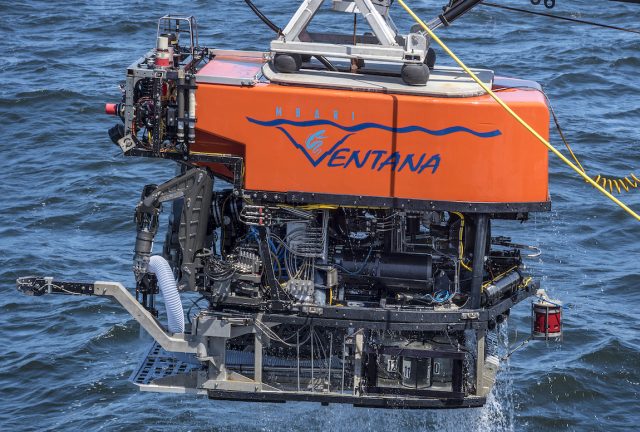 In 2004, Mbari installed a much larger foam pack on Ventana. In 2017, MBARI engineers and marine operations crew replaced the vehicle’s hydraulic system. (Image credit: Monterey Bay Aquarium)
In 2004, Mbari installed a much larger foam pack on Ventana. In 2017, MBARI engineers and marine operations crew replaced the vehicle’s hydraulic system. (Image credit: Monterey Bay Aquarium)
The ROV Ventana embodies MBARI’s guiding principles and founder David Packard’s legacy—innovate and build, explore and protect, and inspire and engage.
With Monterey Bay as our testbed, MBARI works to create and globally scale the research and technology required to explore, map, and monitor the ocean. MBARI’s proximity to Monterey Canyon allowed us to adopt a unique operational mode for Ventana—day trips.
“Every day on Ventan brings a new mission,” explained ROV/MARS Manager Knute Brekke, who was previously a pilot with Ventana for 12 years. “Today you might be working for a midwater biologist, tomorrow for a benthic ecologist, then the next day for an engineer testing a new instrument. Ventana changes configurations all the time. You’re always on the go with Ventana.”
“We can’t overstate how important Ventana is as a platform for engineering. MBARI’s access to Monterey Canyon, the versatility of Ventana, and the expertise of our pilots and marine operations crew have enabled remarkable breakthroughs in ocean technology. Mapping technology developed on Ventana is revolutionizing our understanding of the seafloor,” said Caress.
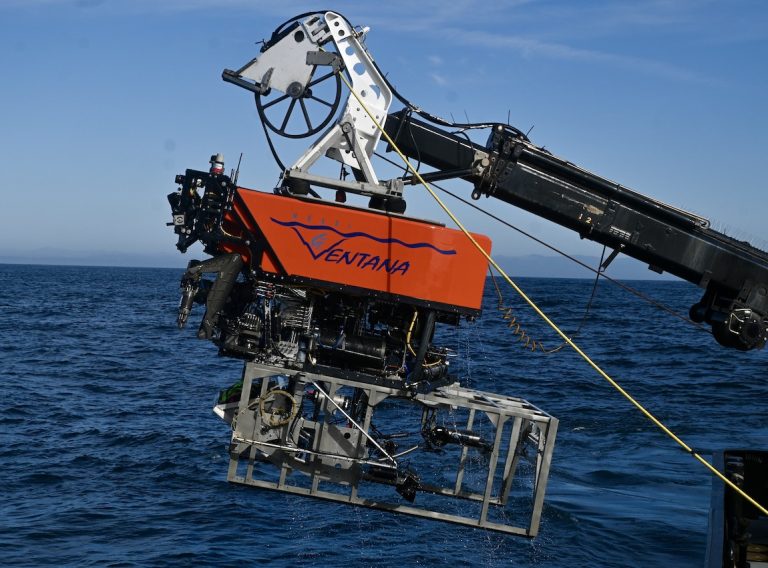 The ROV Ventana operates in Monterey Canyon, a large submarine canyon just offshore of MBARI’s research facilities. Such convenient access to the deep sea makes Ventana an ideal platform for testing new technology developed by MBARI engineers, like this innovative sensor suite for high-resolution seafloor mapping. (Image credit: Dave Caress, MBARI)
The ROV Ventana operates in Monterey Canyon, a large submarine canyon just offshore of MBARI’s research facilities. Such convenient access to the deep sea makes Ventana an ideal platform for testing new technology developed by MBARI engineers, like this innovative sensor suite for high-resolution seafloor mapping. (Image credit: Dave Caress, MBARI)
Just 25 percent of the seafloor has been mapped at resolutions high enough to provide details about how organisms use this unique habitat. New tools and techniques are needed to reveal seafloor geology and biology over large areas, particularly in rugged terrain and areas of societal and ecological significance. Ventana served as a testing platform for one such tool—MBARI’s custom-designed Low-Altitude Survey System (LASS).
The LASS sensor suite combines multibeam (sonar) bathymetry, lidar (laser) bathymetry, and stereo photography to visualize the seafloor in remarkable clarity, detailing geological and biological features of the ocean floor at centimeter-scale. This system was prototyped on the ROV Ventana and is now in operation on the ROV Doc Ricketts.
The LASS executes a path programmed in advance, then MBARI engineers process the data to assemble a map. Caress has been working with Principal Engineer Giancarlo Troni and the CoMPAS Lab on software that will allow the sensor suite to build a map in real time. This is a critical next step in efforts to integrate the mapping instrumentation on autonomous underwater vehicles.
“This dive series was very typical for the engineering testing that our team runs with Ventana,” explained Caress. “We were trying to make some things work that had failed before, we were refining aspects of the operation, and we were attempting a new approach to real-time data processing for the first time, all while generating a useful map of an area of the seafloor where our biologist colleagues study the communities of sponges and other animals.”
“Ventana” is Spanish for “window,” and true to its name, the vehicle serves as MBARI’s window into the deepsea.
The submersible’s cameras collect observations of life in Monterey Canyon. A fiber-optic tether carries live deep-sea video to the control room on the R/V Rachel Carson. In 1999, Ventana was the first ROV to carry a high-definition camera. Earlier this year, MBARI engineers installed a new camera to record in ultra high-definition 4K, allowing scientists to film deep-sea animals and habitats in remarkable clarity.
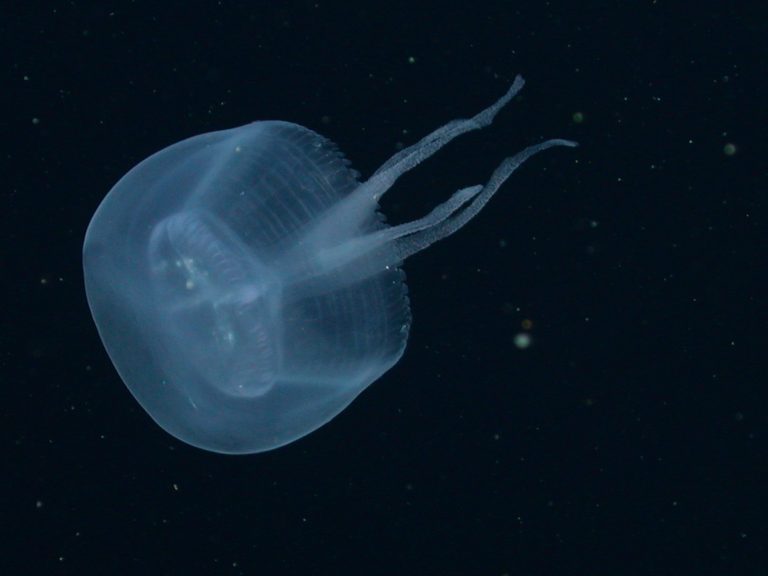 MBARI innovation has greatly expanded the operational capacity for ROV Ventana in the midwater, allowing researchers to document the astonishing diversity of previously unknown delicate drifters. The bumpy jelly (Stellamedusa ventana) is one of several new species described by MBARI scientists and is named after Ventana. (Image credit: MBARI)
MBARI innovation has greatly expanded the operational capacity for ROV Ventana in the midwater, allowing researchers to document the astonishing diversity of previously unknown delicate drifters. The bumpy jelly (Stellamedusa ventana) is one of several new species described by MBARI scientists and is named after Ventana. (Image credit: MBARI)
Ventana fundamentally changed our understanding of the midwater—the vast expanse of water between the surface and the seafloor. Thousands of dives with the ROV Ventana revealed this realm was far more densely populated, complex, active, and ecologically structured than scientists had imagined.
“One of the principal innovations we developed with Ventana was our proficiency for working in midwater. We have learned from direct observations what many midwater species eat, how they catch their prey, how they avoid being eaten themselves, how they utilize bioluminescence, and many more aspects of their behavior,” said Robison. “No other ROV program comes close to our capabilities and success in midwater research.”
Robison and MBARI’s Midwater Ecology Team have observed some remarkable species through the “eyes” of Ventana. One of the most memorable was an encounter with the barreleye fish (Macropinna microstoma). This species was originally described from specimens collected with trawl nets. Only when Ventana recorded the first footage of a barreleye in situ were the fish’s unique transparent head and feeding behavior revealed.
Video recorded by Ventana has been integral in MBARI’s efforts to document the diversity of life that dwells deep beneath the ocean’s surface. MBARI and our collaborators have described more than 225 previously unknown deep-sea species. One of these discoveries—the bumpy jelly (Stellamedusa ventana)—was even named in honor of the vehicle.
Once a month, Robison and the Midwater Ecology Team conduct transects at a midwater research site in Monterey Canyon. While these transects now leverage autonomous vehicles, Ventana’s observations provided the foundation. This time series project has yielded a unique 30-year dataset of the mesopelagic community in Monterey Bay—there is nothing else like it in the world. Ventana has provided invaluable insight into the ecology of the deep midwater.
The deep sea is the foundation for a healthy, functioning ocean and a stable climate, but its future is fragile. This environment faces the same threats as the rest of the ocean—fishing pressure, habitat destruction, plastic pollution, and climate change—but is less resilient to these disturbances. Ventana has conducted research on each of those challenges.
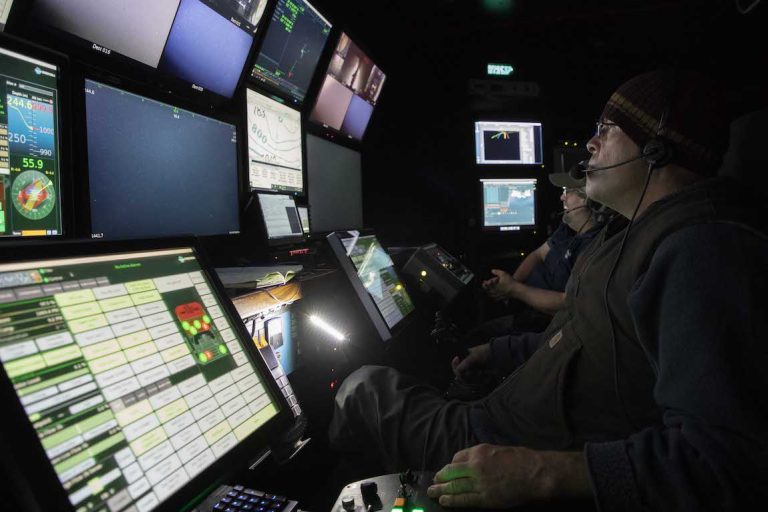 Bringing the deep sea to land was an enormous, unprecedented challenge. Into the Deep leveraged decades of innovation by the Aquarium’s animal care team and 30 years of MBARI innovation with the ROV Ventana to bring deep-sea animals to public display. (Image credit: Lori Eanes, Monterey Bay Aquarium)
Bringing the deep sea to land was an enormous, unprecedented challenge. Into the Deep leveraged decades of innovation by the Aquarium’s animal care team and 30 years of MBARI innovation with the ROV Ventana to bring deep-sea animals to public display. (Image credit: Lori Eanes, Monterey Bay Aquarium)
MBARI’s unique partnership with the Monterey Bay Aquarium aims to educate the public about the ocean. Last year, MBARI and the Aquarium brought the deep sea to land in the groundbreaking new exhibition, Into the Deep: Exploring Our Undiscovered Ocean / En lo Profundo: Explorando Nuestro Océano Desconocido.
MBARI vessels and vehicles—including the ROV Ventana—and the expertise of our marine operations team were instrumental in bringing rarely seen deep-sea animals to public display.
“The opportunity to work with a vehicle like Ventana is something truly special. Ventana has been instrumental to our Into the Deep exhibit, and the pilots and engineers have developed equipment and collection techniques that allow us to exhibit species most people have never seen before,” said Monterey Bay Aquarium Senior Biologist Mary McCarthy.
Members of the Aquarium’s Animal Care team frequently go to sea with the R/V Rachel Carson and ROV Ventana to collect animals for the Into the Deep exhibition. These collecting cruises have allowed Aquarium biologists to exhibit unique animals like the bloody-belly comb jelly (Lampocteis cruentiventer)—a species first described and named thanks to observations made from Ventana—and fire star (Hymenodiscus sp.) that have never been on display at a public aquarium before. Last month, the Association of Zoos and Aquariums honored the Into the Deep exhibition with its Innovation Award, recognizing excellence in the areas of live-animal display and exhibit design.
Into the Deep highlights the connection we share with the deepsea. It immerses the public in this extraordinary environment and showcases the astonishing diversity of life that calls it home. We hope celebrating this unique environment, and its inhabitants, encourages visitors to protect this special place.
With the ocean at a critical crossroads, we need to grow our community of ocean stewards. Whether meeting the denizens of the deep face to face or engaging with MBARI’s discoveries on social media, we hope to inspire a new generation of ocean explorers.
“The coolest thing about our job as pilots is giving somebody else the opportunity to experience the awe and wonder of the deepsea. I’ve been flying ROVs for more than 35 years. Working alongside scientists and engineers and watching their faces light up when they see a deep-sea animal for the first time or successfully deploy a new scientific instrument, it’s still pretty special,” said Brekke.


